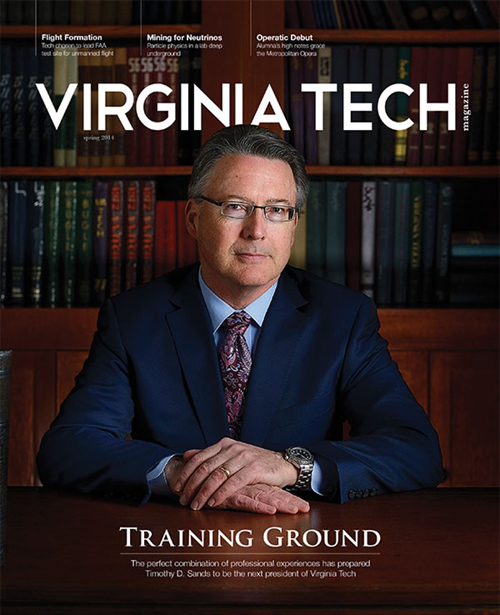Virginia Tech Magazine reviews the career of the university's next president

As Virginia Tech prepares to welcome its 16th president, Timothy D. Sands, into office on June 1, the spring 2014 edition of Virginia Tech Magazine looks at Sands' years of training and his career as a researcher, professor, and administrator.
Sands is currently the provost at Purdue University, a university whose profile is remarkably similar to Virginia Tech's.
The edition's cover story also introduces the incoming first lady, Laura Sands, a quantitative psychologist and biostatistician whose research at Purdue has focused on improving the efficiency and effectiveness of care pathways for vulnerable older adults.
In the wake of Virginia Tech's selection as one of only six elite test sites in the U.S. to sort out issues in integrating unmanned aircraft into national airspace, experts across the university are working with autonomous technologies that have enormous economic potential.
Known for its high-quality, applied geospatial information research in such areas as safety and security, health information technology, and community resilience, Virginia Tech's Center for Geospatial Information Technology is helping eastern U.S. wineries select the best grapes for their vineyards.
And the latest installment of How Tech Ticks goes 1,400 feet underground to a laboratory in a working limestone mine in nearby Giles County, Va., where researchers in the Kimballton Underground Research Facility study subatomic particles away from the background radiation that saturates the earth's surface.
The Web version of Virginia Tech Magazine features online-only multimedia content. Request hard copies by emailing Jesse Tuel, magazine editor.
Dedicated to its motto, Ut Prosim (That I May Serve), Virginia Tech takes a hands-on, engaging approach to education, preparing scholars to be leaders in their fields and communities. As the commonwealth’s most comprehensive university and its leading research institution, Virginia Tech offers 240 undergraduate and graduate degree programs to more than 31,000 students and manages a research portfolio of $513 million. The university fulfills its land-grant mission of transforming knowledge to practice through technological leadership and by fueling economic growth and job creation locally, regionally, and across Virginia.










